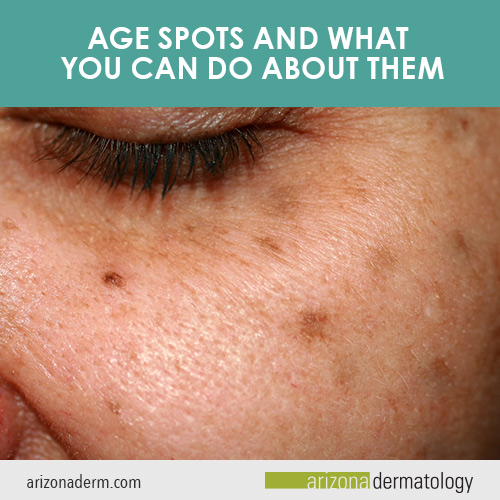 Have you noticed clusters of tan or brown spots on your skin? Have these spots gradually appeared over time? If so, it’s likely that you’ve got age spots. Also known as liver spots, solar lentigo, senile lentigo, or sunspots, these flat, tan, or brown spots are due to an excessive production of melanin, the skin pigment. The term “age spots” aptly characterizes these small marks on the skin, as they are most frequently observed in adults aged 50 and over. However, they can appear in individuals of any age.
Have you noticed clusters of tan or brown spots on your skin? Have these spots gradually appeared over time? If so, it’s likely that you’ve got age spots. Also known as liver spots, solar lentigo, senile lentigo, or sunspots, these flat, tan, or brown spots are due to an excessive production of melanin, the skin pigment. The term “age spots” aptly characterizes these small marks on the skin, as they are most frequently observed in adults aged 50 and over. However, they can appear in individuals of any age.
Locations of Age Spot Formation
Age spots tend to manifest on areas of the body that are frequently exposed to sunlight. While the specific locations can vary from person to person, the following areas are commonly associated with age spot development:
- Face
- Hands
- Shoulders
- Arms
- Upper back
Risk Factors for Age Spots
At Arizona Dermatology, we treat age spots across a diverse range of patients. Regardless of age, gender, or ethnicity, anyone can be at risk of developing these spots. In many cases, those who develop age spots fall into one or more of the following categories:
- Individuals aged 40 and above
- People with fair skin
- Those who do not adequately shield themselves from the sun
- Individuals with a history of frequent sun exposure
- People who have a history of regular tanning
Distinguishing Age Spots from Other Skin Issues
Age spots are often mistaken for other skin conditions, such as freckles or moles. Freckles are smaller and tend to be more evenly distributed across the skin, while age spots are larger and can cluster together. Moles are raised and can have irregular borders, unlike the flat appearance of age spots. It’s essential to consult a dermatologist to accurately diagnose the type of skin discoloration you’re experiencing. In some cases, a growth you may think is an age spot can actually be a form of skin cancer.
Managing Age Spots
Though age spots are generally harmless, they can still be a source of frustration. If they affect your quality of life or self-confidence, we recommend considering treatment options. Proper treatment can enhance self-esteem, improve skin appearance, and promote healthier skin tone and texture.
At Arizona Dermatology, we advocate a two-pronged approach to dealing with age spots: preventive measures and professional dermatological treatments.
Preventive Measures
Prevention is key when it comes to age spots. Practicing sun safety measures can significantly reduce the likelihood of developing age spots. This includes wearing broad-spectrum sunscreen with at least SPF 30 daily, seeking shade during peak sun hours, wearing protective clothing, and avoiding tanning beds. Incorporating these habits into your routine can help minimize the effects of UV exposure and the subsequent development of age spots.
Dermatological Treatments
In the event that preventive measures fall short and age spots do appear, we recommend exploring the following treatments:
Intense Pulse Light Therapy (IPL)
IPL therapy, also referred to as a photofacial, employs skin resurfacing techniques to achieve remarkable results. The Palomar Icon system emits high-intensity light pulses with a range of wavelengths that penetrate the skin’s deeper layers. This light energy transforms into heat, targeting and breaking down melanin pigments. The resulting fragmented pigments are naturally absorbed by the body, reducing discoloration. IPL therapy yields visible outcomes with minimal to no downtime.
Chemical Peels
Chemical peels utilize specialized solutions to gently remove the outer layer of skin. After the procedure, fresh skin emerges, replacing the old skin. This new skin typically exhibits improved smoothness, reduced wrinkles, and freedom from age spots.
Cryotherapy
Cryotherapy involves the application of liquid nitrogen to fade age spots. The freezing action prompts natural peeling over time. Given its slightly invasive nature, recovery time averages one to two weeks.
Topical Prescription Medications
Prescription medications and topical creams offer another avenue for treating age spots. Common prescriptions include hydroquinone and tretinoin, both of which work to gradually fade age spots. However, bear in mind that changes resulting from prescription medications require time. In some instances, visible changes might take several months to become apparent.
Should I Monitor Age Spots?
Yes, regularly monitoring your skin for changes is crucial, especially if you have age spots or are at risk of developing them. If you notice any irregularities, such as changes in size, shape, color, or texture of your age spots, come see us right away. What you think is an age spot might actually be something more serious, such as skin cancer.
What Comes Next?
If your age spots are concerning you, contact us at Arizona Dermatology. Our dedicated and knowledgeable staff are available at our seven locations throughout the Valley.


